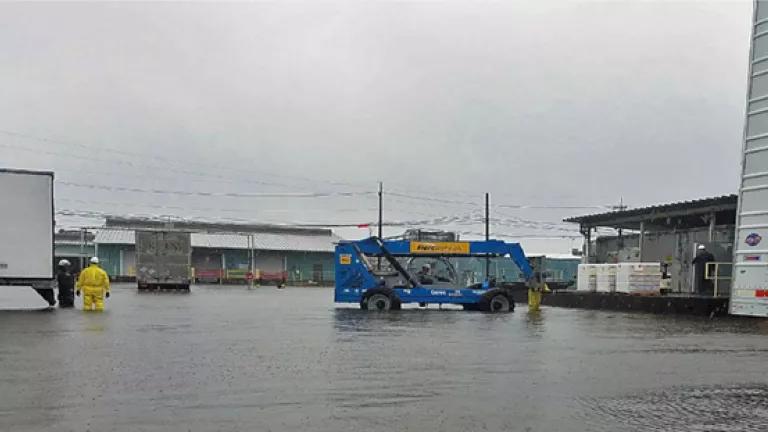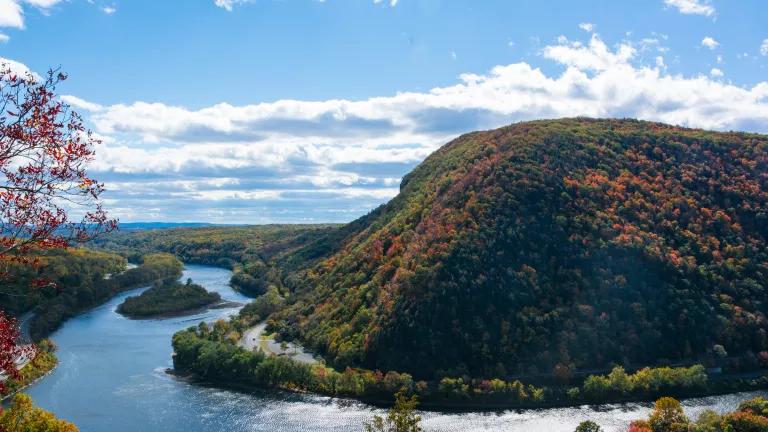Mission Not Accomplished: Environmental Coalition Petitions EPA to Ensure GE Doesn't Abandon Its PCB Mess in the Hudson River

Today, NRDC - along with Hudson River Sloop Clearwater, Riverkeeper, Scenic Hudson, and the Atlantic Chapter of the Sierra Club - sent a petition to the U.S. Environmental Protection Agency (EPA) demanding that it take a hard look at the impact of the hundreds of thousands of pounds of toxic PCBs that the agency is preparing to let the multi-billion dollar General Electric Corporation leave in the Hudson River.
For those following the issue, you know what a problem these remaining PCBs pose to the health of New Yorkers, the vitality of one of our most treasured resources, and the economy of the Hudson River valley.
For those just tuning in, however, your recollection of the issue may go something like this: GE dumped millions of pounds of toxic PCBs in the Hudson River, EPA ordered the company to address them by digging them up ("dredging") and removing them, and now everything is ok, right?
Wrong.
Here's how things have really gone down:
Great Expectations and Bad Data
In 2002 - after almost 30 years of GE fighting tooth and nail to avoid responsibility for the PCBs it dumped in the Hudson - EPA ordered the company to move forward with a limited cleanup plan, designed to address what EPA thought was 65 percent of the PCBs in only the upper 40 miles of the Hudson River Superfund site.
GE agreed to this limited cleanup in 2005, but there was one big problem: from the start, EPA was (very) wrong about how many PCBs were in the river. In fact, extensive sampling done by EPA after issuing the 2002 decision (with over 9,000 samples taken), demonstrated that EPA had underestimated the amount of PCBs in the Upper Hudson by a factor of 2-3 times.
Not only that, many of the processes that EPA had thought would take care of PCBs "naturally" weren't happening at the rates the agency anticipated, and in some places, not happening at all.
Lost Opportunities
Despite knowledge of the earlier miscalculation, both EPA and GE moved forward with the cleanup as planned. By 2012, however, the year EPA performed its first mandatory "five-year review" (which looks at whether the cleanup is protective of "human health and the environment"), it was already clear that there were problems.
By that time, two major federal agencies studying the Hudson - the National Oceanic and Atmospheric Administration ("NOAA") and the U.S. Fish and Wildlife Service ("USFWS") - among others, had raised concerns about the greater-than-expected levels of PCBs. Both NOAA and USFWS concluded that the EPA cleanup plan, unless modified, would leave the "equivalent to a series of Superfund-caliber sites" in the Hudson (emphasis added).

But EPA ignored the concerns of its sister agencies, and therefore missed an opportunity at its 2012 Review to thoroughly analyze whether those concerns were well-founded. With little new analysis critically examining the impact of the much greater-than-expected amounts of PCBs that would be left after the cleanup, EPA decided simply to stay the course with its limited cleanup plan.
Facing Facts: New Analysis Shows Bad News
Thankfully, NOAA was not deterred and kept studying the issue. And in 2015, it released the results of its own computer modeling - the first publically-available modeling conducted since 2002 - that showed about what you'd expect: because the Hudson was substantially more contaminated than anticipated, the EPA plan would not achieve key health and safety cleanup targets for the River.
Specifically, the NOAA analysis predicted that surface concentrations of PCBs would be 3-5 times higher than expected after the cleanup and that many fish would be contaminated with unsafe levels of PCBs for as much as 40-50 years longer than anticipated.
So Where Are We Now?
Things are moving fast (at least by Superfund standards). GE finished the limited, original plan for the cleanup this October. Immediately after, it asked for permission to shutter a key piece of cleanup infrastructure - namely, its multi-million-dollar sediment processing facility. Despite objections from NRDC and our Hudson River allies, EPA signed-off on the dismantling of this dredging infrastructure. And as things now stand, GE will likely seek final "certification of completion" of the cleanup from EPA as early as this summer.
Which brings us to why we are filing our petition today: if the NOAA analysis is right, it will be roughly a hundred years from when the Hudson fishery was shut down until Upper Hudson fish are even marginally edible again. And in the meantime, PCBs in the sediments, the water, and even the air around the Hudson, will continue to threaten New York residents and hurt the upriver economy.
These threats are serious ones, and they warrant much more than the "rubber stamp" review the agency performed in 2012. Instead we need real, in-depth analysis of whether this cleanup will really make the Hudson River safe. And because that type of review takes time, EPA must act immediately. Too much is at stake not to - namely, the health and vitality of the Hudson and the millions of New Yorkers who depend on it.




